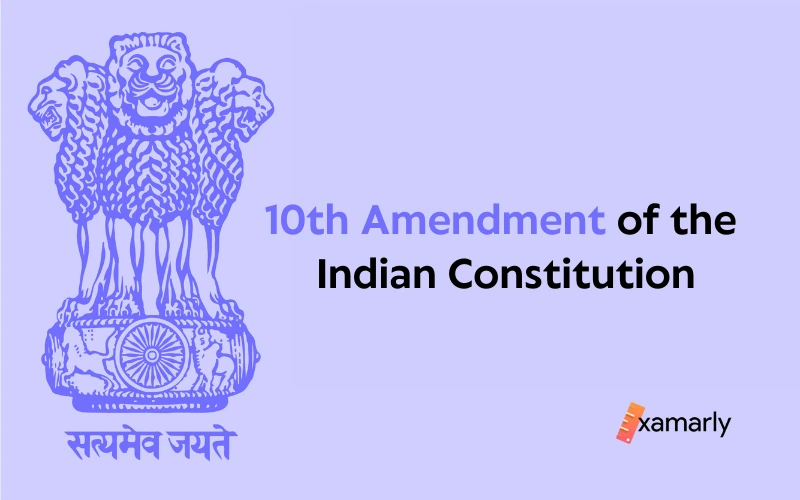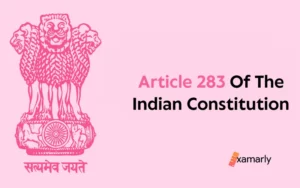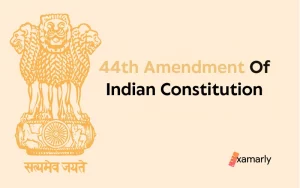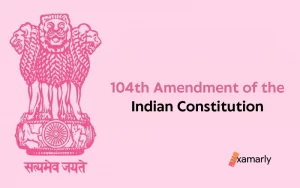The 10th Amendment of the Indian Constitution came into existence after the renewal of the First Schedule of the Indian Constitution. It is officially called The Constitution (Tenth Amendment) Act, 1961.
Following its renewal, it enabled Dadra and Nagar Haveli to become the seventh Union territory of India. The Union territory of Dadra and Nagar Haveli is now included in Article 240, Clause (1).
This blog on the 10th Amendment of the Indian Constitution will facilitate your UPSC preparation. Let us dive into the details of this constitutional amendment.
- 10th Amendment of the Indian Constitution: Background
- The 10th Amendment Bill, 1961
- Statement of Objects and Reasons
- Proposal and enactment
- Important provisions and significance
- Conclusion
- FAQs about the 10th Amendment of the Indian Constitution
- What is the official name of the 10th Amendment of the Indian Constitution?
- In which year was the 10th Amendment Act of the Indian Constitution passed?
- When did India and Portugal sign a treaty?
- Who became the one-day Prime Minister of Dadra and Nagar Haveli?
- When did the 10th Amendment of the Indian Constitution take effect?
10th Amendment of the Indian Constitution: Background
The Portuguese conquered Nagar Haveli on June 10, 1783. This act was under a Friendship Treaty signed on December 17, 1779. It was to make up for the Maratha Navy’s damage to the Portuguese frigate.
In 1954, the residents of Dadra and Nagar Haveli joined hands with volunteers from several organizations. The Rashtriya Swayamsevak Sangh (RSS), the United Front of Goans (UFG), the Azad Gomantak Dal, and the National Movement Liberation Organisation (NMLO) came together.
Their motive was to abolish Portuguese rule on the land of Dadra and Nagar Haveli. Despite its de facto independence, Dadra and Nagar Haveli was still recognised as Portuguese territories internationally. For example, by the International Court of Justice.
Residents of the erstwhile colony requested administrative help from the Government of India. The appointed administrator was the IAS Officer KG Badlani. From 1954 to 1961, the territory was governed by the Varishta Panchayat of Free Dadra and Nagar Haveli.
India and Portugal signed a treaty on December 31, 1974. The purpose of doing so was to recognize India’s sovereignty over Daman, Diu, Goa, Dadra and Nagar Haveli.
Also Read: Ultimate Guide: 9th Amendment of the Indian Constitution
The 10th Amendment Bill, 1961
The 10th Amendment of the Indian Constitution has a history of over fifty years. Its purpose was to make Indian laws more relevant to the changing society. It was drafted by Jawaharlal Nehru and introduced to the country in 1961.
Laxmi Menon was the Deputy Minister of External Affairs during that time. She put forth the Tenth Amendment bill, 1961 in the Lok Sabha. President Rajendra Prasad expressed his approval of the bill. He signed it on August 16, 1961.
Statement of Objects and Reasons
The Statement of Objects and Reasons was affixed to the bill. This bill sought to fulfil the requests that had been put forward. They have been summarized in the following lines.
- The people and the Varishta Panchayat of Free Dadra and Nagar Haveli constantly proclaimed to the Government of India. They called for their territories to be incorporated with the Union of India.
- On June 12, 1961, their plea was consolidated in an official Resolution. This was taken up by the Varishta Panchayat.
- In consideration of the request made by the residents, the Government of India decided in their favour. These Union territories had the full right to be unified with the Union of India.
- The Bill also called for the revision of the First Schedule to the Constitution to demarcate specific areas. These areas would come under the Union territory of Dadra and Nagar Haveli.
- Also, it requested the amendment of clause (1) of Article 240 of the Constitution of India. This would allow the inclusion of the Union territory of Dadra and Nagar Haveli.
- Furthermore, this would allow the President to ensure peace, progress, and good governance of the territory by making appropriate regulations.
Proposal and enactment
The 10th Amendment of the Indian Constitution Bill, 1961 (Bill No. 43 of 1961) was tabled in the Lok Sabha on August 11, 1961.
Laxmi Menon was then serving as the Deputy Minister of External Affairs. She is credited with the introduction of the bill which proposed to alter Article 240 along with the First Schedule to the Constitution.
Despite the rigorous discussion, the Lok Sabha passed the bill unchanged on August 14, 1961. Following this event, on August 16, 1961, the Rajya Sabha debated and approved it.
Then-President Rajendra Prasad accepted the bill. He signed it on August 16, 1961. This resulted in the Tenth Amendment of the Indian Constitution retroactively coming into effect on August 11, 1961.
Important provisions and significance
- Modification of the First Schedule to the Constitution. This was to incorporate Dadra and Nagar Haveli as the seventh Union territory of India.
- Furthermore, Article 240(1) was modified to add Dadra and Nagar Haveli to the list of Union Territories. This was to provide the President with the authority to issue regulations for the peace, progress, and effective administration in favour of the territory.
You Might Also Like: 11th Amendment of the Indian Constitution
Conclusion
Through this blog for UPSC preparation, you got to learn that the 10th Amendment of the Indian Constitution played an instrumental role in assigning Dadra and Nagar Haveli the Union Territory status.
This amendment granted authority to the President in favour of creating laws for the peace, progress, and effective administration of the area.
The 10th Amendment of the Indian Constitution was implemented on August 11, 1961. It was enforced retroactively.
FAQs about the 10th Amendment of the Indian Constitution
What is the official name of the 10th Amendment of the Indian Constitution?
The Constitution (Tenth Amendment) Act, 1961.
In which year was the 10th Amendment Act of the Indian Constitution passed?
1961.
When did India and Portugal sign a treaty?
December 31, 1974.
Who became the one-day Prime Minister of Dadra and Nagar Haveli?
In 1961, KG Badlani, an Indian Administrative Service official, was appointed as Head of State for one day to sign an agreement with Prime Minister Jawaharlal Nehru to unite the province of Dadra and Nagar Haveli into the Republic of India.
When did the 10th Amendment of the Indian Constitution take effect?
The 10th Amendment of the Indian Constitution was implemented on August 11, 1961. It was enforced retroactively.






